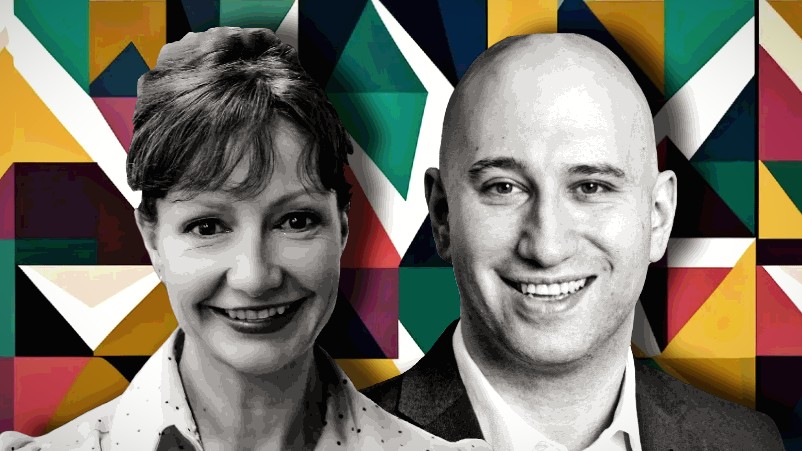Fisher & Paykel’s Chief Digital Officer says AI co-pilots and agents with ‘reasoning engines’, not LLMs, provide the breakthrough in AI-led marketing, customer service, ecom

Fisher & Paykel's Sarah Lukins and Rudi Khoury
Top digital marketing and customer execs at the fancied $22bn New Zealand appliances giant Fisher & Paykel are quick to acknowledge they were “just very lucky” to have had colleagues “passionate about getting the data right early on”. Because as AI deployments gather pace – along with corporate frustration – Fisher & Paykel has been able to test, adapt and deploy fast from bots to co-pilots and now autonomous AI agents. The business has been “hot” on clean data for some time, says Chief Digital Officer Rudi Khoury and General Manager of Digital Sarah Lukins, underpinning their confidence in early trials that autonomous AI agents powered by Salesforce’s “reasoning engine” will ultimately solve “80-90 per cent” of the company’s customer contact volumes at much higher satisfaction levels than today. It’s only part of the Fisher & Paykel plan for AI across marketing, customer service and ecommerce, but it’s where some of the early learning and gains are being made.
We've played with every single copilot there is. The challenge with copilots… and what they're missing is a reasoning engine on top of the LLM to actually understand the topic and question that it's being asked, then be able to coordinate responses that are more relevant and accurate.
Reasoning rules
Fisher & Paykel’s top digital execs are “hot” on “clean data” and equally so on the arrival of reasoning engines coupled to LLMs to create autonomous agents “with a brain” that land better results than legacy AI bots and co-pilots across customer, ecom and marketing remits.
Salesforce was earliest to market in September with the announcement of its AI agents powered by a reasoning engine called Atlas. It eliminates the vast workload by humans in building decisioning trees for legacy bots and allows these self-reasoning agents to understand intent and context, then make decisions to take action via simpler, natural language prompt templates managed by people.
Fisher & Paykel deployed the “legacy AI” Einstein bot from Salesforce, which is now handling about 30 per cent of total customer contact volumes. But its capability and usefulness has peaked for Chief Digital Officer Rudi Khoury. He expects when the sandbox trials Fisher & Paykel is conducting currently go live, these smarter autonomous agents with the ability to infer context and meaning and take an action to solve a customer query will double the customer handling volumes to circa 60 per cent or higher.
“Customer service is the one area in AI where customers are used to it but it's not being done very well,” Khoury told Mi3’s CustomerX. “But they're used to it and a lot of customers are willing to have a digital experience first, provided it's a good one. I want to give them that experience where they can help themselves, maybe more than 80 or 90 per cent of the time. And if our customers are happy with that then we want to give them that experience.”
Double effectiveness
Khoury said once Fisher & Paykel had fully launched its Agentforce trials, the new AI reasoning bots in the short-term “could get to two thirds” of completing all customer queries.
“We've played with every single copilot there is. The challenge with copilots… and what they're missing is a reasoning engine on top of the LLM to actually understand the topic and question that it's being asked, then be able to coordinate responses that are more relevant and accurate. To date, there's been very little of that, although that is changing.”
Salesforce was first to market with a reasoning engine behind its new “Agentforce” launch – Fisher & Paykel is a multi-cloud Salesforce user – but Khoury said OpenAI, AWS, Google and Microsoft were also doing likewise. “It's starting to emerge now that it's more than just an LLM, you need a reasoning engine and then on top of that you need agents to actually go do the work as well.”
Khoury said the firm had been using Salesforce Einstein bots for 12 months with “good results” as a “little traffic controller” but he called them “legacy AI” not generative.
From traffic control to human-like responses
“Customers are overwhelmed with how much stuff they have to go through to get a solution - we've got thousands of products and thousands of instruction manuals," Khoury continued. “The Einstein bot was not very sophisticated – it actually helps about one in three customers just get to where they need to go to and it's been a nice little traffic controller. But we want to take it to the next level. We want to ingest all of that information and actually provide proper responses, then be able to take an action off the back of that. That's where we've been piloting and pre-building with Agentforce. We can give it access to our entire knowledge base, for example, ask it a question and get a human-like response, which has been reasoned really well. Then if there's an action that needs to be taken at the end of that, we want them to actually help them drive the action.
"For example, if you need help with your oven, it goes back and forth with you maybe troubleshooting around your oven. If at the end, you need someone to come and service or maintain it, it’s able to take you from that chat experience into a booking experience digitally. If there's an action required, like you've got an order you need to change, it helps you change the order, not just tell you how to change the order.”
Khoury said Salesforce’s autonomous agents were different to the company’s bots and copilots it has used hitherto in that “I don't have to map anything in terms of what the customer might say versus what the solution is".
"What I'm doing is I'm building prompts. You just do it in natural language, in a prompt, and it will do the rest," he explained. "I don't have to explicitly program it. It's actually got some brains, versus kind of the legacy bot experience, which is what we're all doing.”
Fisher & Paykel General Manager, Digital, Sarah Lukins, said the company underwent a relatively painless experience ramping up its AI trials and integrating into existing systems and customer data infrastructure.
“We're just very lucky to have some people in the company who are very passionate about getting the data right early on,” she said. “So that transition has been much more painless. We know that as we've spoken to different vendors and different [industry] colleagues who are quite surprised at how clean our data is comparatively. We’ve been really hot on making sure we were ready to go, to be able to take on these new technologies with much more speed.”
Khoury and Lukins said while the business had bespoke AI investments for its products, “DIY AI” in use cases across marketing, customer experience and ecommerce were mostly redundant for firms like Fisher & Paykel. A bank with deep in-house engineering resources, however, might be different.
“We're a big company, but scale compared to our competitors is different - we're not in the business of building business software, we’re in the business of making beautiful appliances and they have their own technology requirements, their own software requirements. We want to put our investment there.”


